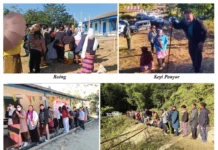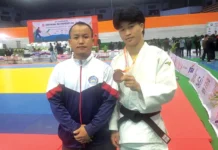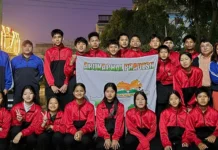[ Aga Rengma ]
I was born into a world where whispers of war and betrayal were as common as the wind. My childhood was shaped by stories of heroes and martyrs, of brothers who became enemies in a cause they once shared. I did not understand the weight of those words then, but I carried them with me.
The struggle for Naga unity is not just a political process; it is a deeply personal one. Just as our people have tried and failed to reconcile, I, too, have wrestled with my own struggles, my own losses, and my own longing for healing. Perhaps that is why this fight for unity feels so personal to me. Because in many ways, it mirrors my own life.
The scars of our past run deep, but so does our longing for unity. This is why the efforts of the Forum for Naga Reconciliation (FNR) matter to me. It is not just about political agreements; it is about healing the wounds that have shaped our lives.
For years, we watched our leaders shake hands, sign agreements, and make solemn promises, only to see them collapse under old rivalries and power struggles. Hope rose, only to be betrayed. But we have also seen the resilience of a people who refuse to give up on each other.
The Covenant of Reconciliation (2009)
I was in high school when I first heard about the Covenant of Reconciliation, the first initiative of the FNR. It felt like hope of a new dawn. For the first time, leaders who were once considered enemies – Isak Chishi Swu of the NSCN (IM), SS Khaplang of the NSCN (K), and S Singnya of the NNC/FGN -stood together and declared an end to inter-factional violence. They did not just make a political agreement; they made a covenant before god.
Imagine Chiang Mai, Thailand, in 2009 -leaders who once shed each other’s blood knelt and washed each other’s feet. It felt like a turning point, a moment when decades of violence might finally end.For a while, it seemed like things were changing. The streets of Dimapur, Kohima, and other Naga towns felt less tense. We no longer woke up to news of one faction assassinating members of another. For the first time in years, there was a fragile peace.However, though the covenant brought peace, it couldn’t unite the factions.
The Naga Concordant (2011)
The next remarkable effort of the FNR towards Naga unity came about when I was in college. Though thefratricidal killings stopped, the divisions remained. The Naga Concordant, signed in 2011, was supposed to be the next step, a commitment to work toward a single Naga national government, agreed upon in principle.
Unfortunately, the high-level commission that was supposed to turn this vision into reality failed to function as intended. Also, despite the Naga Concordant, new factions emerged due to leadership disputes and ideological differences, further complicating the unification process.
All along, I was beginning to understand the complexities of human nature. College was where I learned that even the closest of friendships could break under the weight of misunderstandings. I had friends, brothers in all but blood, who drifted apart because of ego, pride, stubbornness and betrayal. We had promised each other that nothing would come between us. Yet, we let it happen anyway.
Just like the Naga factions, we had all the right intentions. We wanted unity, but we lacked the will to sacrifice for it and sometimes selfishness took over. And so, the Naga Concordant faded into history, just as some of my closest friendships faded into memory.
The Lenten Agreement (2014)
Then came the Lenten Agreement in 2014, which basically reiterated what was agreed upon in the Naga Concordant; formation of a unified Naga national government. By now, I was no longer just an observer of Naga affairs; I had started advocating our Naga rights, eager to be a part of our nation-buildingprocess. But I had also learned not to hope too much.
Once again, leaders signed. Once again, the FNR facilitated discussions. And once again, we were told that unity was on the horizon. But the horizon remained just that, something always out of reach.The Lenten Agreement faltered partly due to the lack of a strong enforcement mechanism and external influences, such as the GoI’s selective engagement with certain factions while side-lining others, creating mistrust.
The Council of Naga Relationships and Co-operation (2025)
Now, in 2025, we are at another turning point. The FNR, relentless in its pursuit of peace and unity, has proposed the materialization of the Council of Naga Relationships and Cooperation, which was first agreed upon in principle between the NSCN (IM) and the seven NNPGs in 2022 in Kolkata. For the first time, this initiative extends beyond political factions to include tribal bodies and civil society, a move that could finally bring the broader Naga society into the process.
If the Forum for Naga Reconciliation’s initiative falters, we may never have another opportunity of this magnitude. This moment is not just a chance; it is a call to duty. We must rise above differences and rally behind the FNR to transform the Council of Naga Relationships and Cooperation into a lasting reality. Our collective future depends on it.
Reconciliation, whether at a societal level or in our personal lives, is never easy. Losing my wife to cancer in 2021, I was left with my personal, professional, and social life devastated. But life has given me another chance to rebuild, not to restart but continue from where it went wrong. The path forward remains uncertain, yet if my own journey has taught me anything, it is this: we cannot allow our past to define our future.
The Covenant of Reconciliation showed us that peace is possible. The Naga Concordant showed us that peace alone is not enough -we need structural unity. The Lenten Agreement showed us that without enforcement, agreements and commitments are just illusions.
Was unity ever possible?
There was a time I believed the answer was no. But today, I realise that unity, whether in a nation, a family, or within one’s own heart, is never found. It is built, day by day, through hard choices and painful sacrifices.
If the Naga people want unity, we must do more than sign agreements. We must be willing to give up our pride, to be held accountable, to demand transparency from our leaders. We must choose unity, not just in words, but in action.
I do not know if unity was ever truly possible, but I know that without unity, our people will be forever negotiating from a position of weakness. We will be just spectators in our own fate, watching as others decide our future.
A call to action
One key reason why past efforts failed is the lack of public accountability. To ensure accountability, a coalition of students, youths, civil society, and tribal bodies could be established to track commitments, enforce accountability and demand transparency.
Accountability cannot just exist on paper. Civil society must be ready to withdraw cooperation from groups that prioritise personal ambition over national unity. If any faction violates reconciliation and unification efforts, civil society must publicly withdraw support by
# Denouncing them in official statements.
# Refusing to cooperate in political or economic dealings.
# Encouraging Naga people to boycott any faction that obstructs unity.
If we, as a people, unite in this demand, we may finally break free from the past and build a future that belongs to all Nagas. We fought for our rights, for our identity, for our future, but what is a future without unity? The path ahead is uncertain, but the choice is clear. Either we stand together, or we fall apart.
And I, for one, refuse to watch us fall. (The contributor is convener, Western Naga Youth Front)



